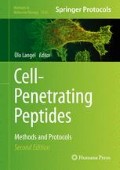Abstract
The efficient transfection of cloned genes into cells has a critical role in nucleic acid-based therapeutic applications, molecular and cell biology studies, and the production of recombinant proteins in cultured cells. Using a stearylated cell-penetrating peptide (CPP) NickFect51, we have generated an effective, universal, and convenient method for the delivery of DNA vectors into animal cells derived from different origins (mammalian, avian, insect). The CPP-mediated transfection described in detail herein is efficient for many regular cell lines commonly used for research purposes and it is especially suitable for transfection of protein production cell lines adapted for growth in chemically defined serum-free medium.
Access this chapter
Tax calculation will be finalised at checkout
Purchases are for personal use only
References
Geisse S, Fux C (2009) Recombinant protein production by transient gene transfer into Mammalian cells. Methods Enzymol 463:223–238
Gao X, Kim KS, Liu D (2007) Nonviral gene delivery: what we know and what is next. AAPS J 9:E92–E104
Lehto T, Kurrikoff K, Langel Ü (2012) Cell-penetrating peptides for the delivery of nucleic acids. Expert Opin Drug Deliv 9:823–836
Mäe M, El Andaloussi S, Lundin P et al (2009) A stearylated CPP for delivery of splice correcting oligonucleotides using a non-covalent co-incubation strategy. J Control Release 134:221–227
Lehto T, Simonson OE, Mäger I et al (2011) A peptide-based vector for efficient gene transfer in vitro and in vivo. Mol Ther 19:1457–1467
Arukuusk P, Pärnaste L, Oskolkov N et al (2013) New generation of efficient peptide-based vectors, NickFects, for the delivery of nucleic acids. Biochim Biophys Acta 1828:1365–1373
Silla T, Hääl I, Geimanen J et al (2005) Episomal maintenance of plasmids with hybrid origins in mouse cells. J Virol 79:15277–15288
Chiou HC, Vasu S, Liu CY et al (2014) Scalable transient protein expression. Methods Mol Biol 1104:35–55
Kushnir N, Streatfield SJ, Yusibov V (2012) Virus-like particles as a highly efficient vaccine platform: diversity of targets and production systems and advances in clinical development. Vaccine 31:58–83
Green MR, Sambrook J (2012) Chapter 1: Isolation and quantification of DNA. In: Molecular cloning: a laboratory manual, 4th edn. Cold Spring Harbor Laboratory Press, New York, pp 11–78
Strober W (2001) Trypan blue exclusion test of cell viability. Curr Protoc Immunol 21:A.3B.1–A.3B.2
Acknowledgements
We warmly thank Ivar Ilves, Margit Ool, and Mart Toots for their assistance in experimental work. We also thank Anne Kalling, Andres Tover, Urve Toots, and Mart Ustav for their support.
Author information
Authors and Affiliations
Corresponding author
Editor information
Editors and Affiliations
Rights and permissions
Copyright information
© 2015 Springer Science+Business Media New York
About this protocol
Cite this protocol
Karro, K., Männik, T., Männik, A., Ustav, M. (2015). DNA Transfer into Animal Cells Using Stearylated CPP Based Transfection Reagent. In: Langel, Ü. (eds) Cell-Penetrating Peptides. Methods in Molecular Biology, vol 1324. Humana Press, New York, NY. https://doi.org/10.1007/978-1-4939-2806-4_29
Download citation
DOI: https://doi.org/10.1007/978-1-4939-2806-4_29
Publisher Name: Humana Press, New York, NY
Print ISBN: 978-1-4939-2805-7
Online ISBN: 978-1-4939-2806-4
eBook Packages: Springer Protocols

